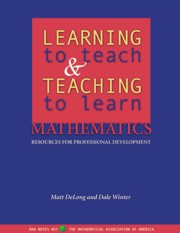Book contents
- Frontmatter
- Preface
- Contents
- 1 The Professional Development Program
- 2 How to Use this Book
- 3 An Orientation Session for the Beginning of the Semester
- 4 Making In-class Groups Work
- 5 Getting Students to Read the Textbook
- 6 Assessing and Evaluating Students' Work
- 7 Managing Homework Teams
- 8 Teaching During Office Hours
- 9 Establishing and Maintaining Control in Your Classroom
- 10 Proctoring Tests and Examinations
- 11 Teaching with Calculators and Computers
- 12 Making Lesson Plans
- 13 Strategies for Motivating Students
- 14 Dealing With Difficult Instructor-Student Situations
- 15 End-of-Semester Administration
- 16 Adapting Materials and Designing Your Own Meetings
- 17 Classroom Visits
- A Tips for Running Meetings
- B The Michigan Introductory Program
- Bibliography
16 - Adapting Materials and Designing Your Own Meetings
- Frontmatter
- Preface
- Contents
- 1 The Professional Development Program
- 2 How to Use this Book
- 3 An Orientation Session for the Beginning of the Semester
- 4 Making In-class Groups Work
- 5 Getting Students to Read the Textbook
- 6 Assessing and Evaluating Students' Work
- 7 Managing Homework Teams
- 8 Teaching During Office Hours
- 9 Establishing and Maintaining Control in Your Classroom
- 10 Proctoring Tests and Examinations
- 11 Teaching with Calculators and Computers
- 12 Making Lesson Plans
- 13 Strategies for Motivating Students
- 14 Dealing With Difficult Instructor-Student Situations
- 15 End-of-Semester Administration
- 16 Adapting Materials and Designing Your Own Meetings
- 17 Classroom Visits
- A Tips for Running Meetings
- B The Michigan Introductory Program
- Bibliography
Summary
Introduction
In developing this book, we have tried to identify a collection of experiences for training college mathematics instructors that is comprehensive and well integrated. This is appropriate, as teaching is a highly complex activity, especially in the setting of a student-centered interactive classroom, and it is somewhat artificial to treat teaching issues as isolated from each other.
The range of experiences that we have described in this book is consistent with our experience of the needs of graduate students and new faculty instructors at the University of Michigan. Naturally, other programs with different goals and methods may find that there are teaching issues that we have not substantially addressed, but which are nonetheless highly relevant. In this chapter, we hope to provide a framework for adapting materials to the specific needs of other programs.
A Process for Designing Your Own Meetings
We believe that instructor training meetings should be as lively as possible, and should actively involve the instructors as much as is possible. In a sense, the training meetings can, and perhaps should, serve as a model for how the instructors' classrooms should function. With this in mind, the “Lesson Planning Worksheet” included in Chapter 12 serves as a useful framework for planning a training meeting.
The major steps described in Chapter 12 are recounted below.
Read the section to be covered.
Identify the goals for the session.
Decide on a strategy to address each goal.
Begin time management.
Plan the student activities.
Write scripts for the mini-lectures.
Make an assessment plan.
Put it all together.
- Type
- Chapter
- Information
- Learning to Teach and Teaching to Learn MathematicsResources for Professional Development, pp. 197 - 204Publisher: Mathematical Association of AmericaPrint publication year: 2002

